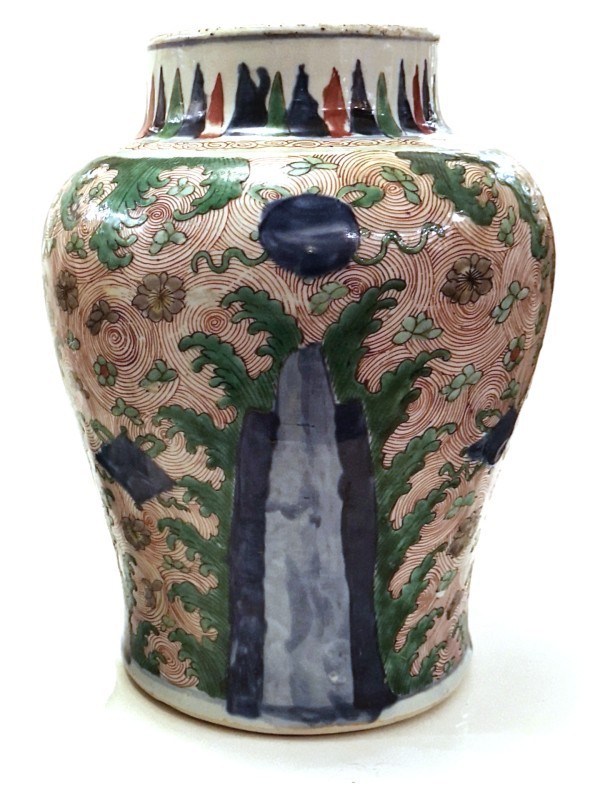
"Porcelain jar, painted in underglaze blue and enamels. Shunzhi period (1644-1661), Transitional period (1640-60). For four similar example see Pinto de Matos, Chinese Export Porcelain. Lisbon 1996, p. 158, fig 79.
Photo: © JE Nilsson, Coll. 2021"
Wucai meaning five enamels or "five color ware" is in reality mostly three enamels (red, green and yellow) within outlines in blackish dry cobalt, underglaze blue, plus the white of the porcelain body, all in all making up five colors.
The name Wucai or Wanli wucai refers to Chinese porcelain decorated in this palette dating from the Ming period (1368-1642, especially during the reign of Jiajing (AD 1522-66), Longqing (AD 1567-72) and Wanli (1573-1619) emperors, who commissioned a variety of porcelain items decorated in this style. The number of colors can differ and become more as the times goes on. This possibly suggest that the important thing is the name wu-cai, or five-color ware, where the number five has an important symbolic significance in Chinese art.
An important innovation of the Jiajing period, the so-called wucai ("five-color") decoration, was one of the last major additions to the lexicon of ornamental techniques that were developed during the Ming dynasty. Despite its name, the number of colors in wucai decoration is not strictly limited to five.
Wucai, like doucai, is a combination of underglaze blue and overglaze polychrome enamels. However, where the soft underglaze blue of doucai was primarily used for dainty outlines that lay the groundwork for elegant little washes of pale enamel colors, the dark blue of wucai was applied in bold washes to complement vigorous splashes of strong overglaze colors, and outlining was mostly done in overglaze red, brown, or black.
The Ming enamels resemble bits of translucent colored glass, that have been fused to the surface of the glaze. While some variety in tone could be achieved with them, gradations in color were quite limited, and any shading of individual colors was virtually impossible.
The polychrome (more than one color) wares of the Song and Yuan are not actually related to wucai. Wucai first appears in the Xuande reign and is fully developed in Jiajing and Wanli. In the early Qing the green becomes more dominant with multiple shades evolving to what is known as Kangxi-wucai (famille verte) with the underglaze blue being replaced with overglaze blue, an invention of the late Kangxi period. There was no overglaze blue prior to the late Kangxi period. As the wucai palette evolved other overglaze enamels were added and sometimes replaced some of the basic original five.
This entry based on A Handbook of Chinese Ceramics, by Suzanne G. Valenstein, Metropolitan Museum of Art (New York, N.Y.) p. 191-193.
A